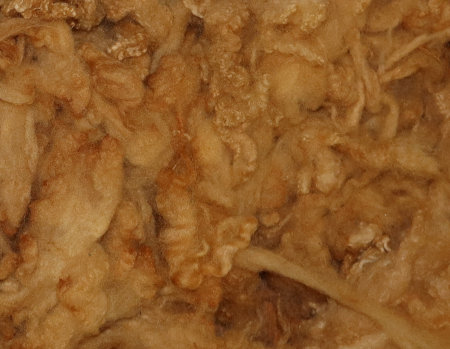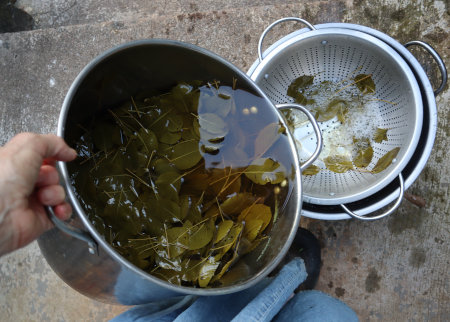Also known as rose mallow, rose of Sharon, or althea. There are a variety of species in the genus. Mine are apparently hibiscus syriacus, and we have quite a few in the yard. Ours range from pale to dark pink and lavender. I have one solid white one. Some commercial hybrids come in red. The dark pink and red ones are said to be the best for dyeing.
Both of the natural dyeing books I'm referencing (
Wild Color and
A Dyer's Garden) give instructions for dyeing with hardy hibiscus, so I picked up tidbits from each.
Collecting the dyestuff
This was a bit of a challenge because I wanted 8 ounces but didn't have enough blooming at any one time to collect enough. One book says the flowers don't freeze or dry well, the other said they can dried. Rita Buchanan suggests picking every day or two and storing in the fridge in a plastic bag. This is what I ended up doing. By the time I had 8 ounces, the ones on the bottom were going bad so I had to discard them. I should have weighed what was left, but didn't think of it at the time.
Preparing the dyepot
- Pour boiling water over the flowers
- Simmer flowers for about 30 minutes.
- Strain
Dyeing the fiber
Jenny Dean's book shows color samples of hardy hibiscus dyed both with amd without a mordant. For this batch, I used
alum mordanted fiber.
I had previously soaked some fiber and had it ready for the dyepot. This time, I didn't wait for the bath water to cool, but added the wet fiber to it while hot.
- Add the wet fiber
- Heat to a simmer
- Simmer 30 to 60 minutes
- Let steep overnight as it cools (can be left longer for deeper color)
Note: when first checked on the pot after putting it on the heat, it was at a rolling boil. I turned it down and left it in the dyebath for close to an hour.
The Results
 |
| Right out of the dyepot, still damp. |
Nowhere near the lavender shades in the dye books!
Here it is after being washed, rinsed, and dried.
Analysis
I appeared to have good color in the dyepot, so what happened? Several things come to mind.
- I was light on the dyestuff because some of the flowers had spoiled. Did I have too few flowers? Possible solution would be to collect fewer flowers and dye smaller quantities of wool.
- Did some of the spoiled flowers get in the dyebath and affect results?
- Did the active boiling have anything to do with it?
- Was it my water (dyed with city tap water)
- Something else?
- On the other hand, here's a quote from Rita Buchanan, A Dyer's Garden page 81.
"Dark hibiscus flowers give fascinating, impressive, but unpredictable colors . . . Every time I use this plant, I get different colors—lilac, purple, mauve, green, gray, brown, black—but they're all interesting and attractive."
In light of that, if I had been going for a light gray, I'd be pleased with the results. It is a lovely color. As it was, however, I was disappointed because I wanted something different. Maybe calling it silver-gray will take the edge off the disappointment. 😉
Definitely, more experimenting is in order.









































